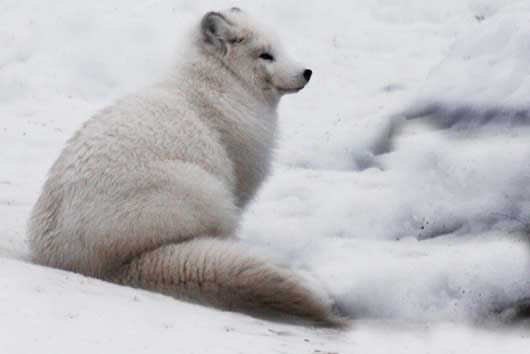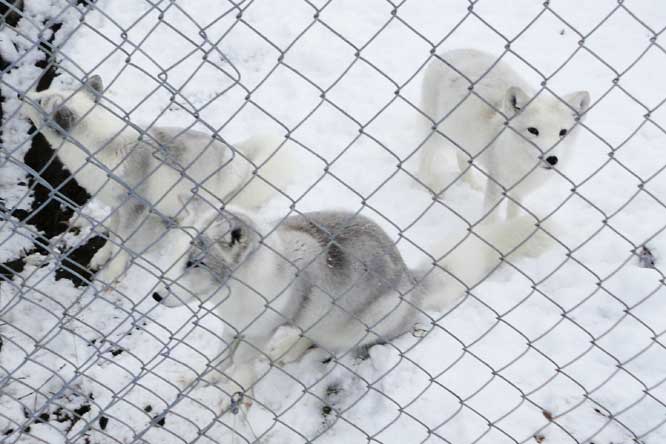Arctic Fox at the Polar Zoo in Northern Norway
If you are lucky enough to visit the Polar Zoo when the arctic foxes have their full white winter coat you will be seeing them at their prime. They are so pretty. They are like little lap dogs.

They are so pretty. They are like little lap dogs. The type of pet that you would see a posh French socialite walking down the Champs-Elysees in Paris. These arctic foxes are no pets. They are mean killers that live off hunting small mammals and birds. When it gets warm they moult and their thick winter coat falls out and changes to a brown colour so that they are not so conspicuous when the snow melts.
As you cross the river and start your ascent of the hill in the Zoo's park you might hear them before you see them. The arctic fox has a yap for a bark. When they get together or when they see something interesting they start yapping at each other as if they are saying to their mates come and look at this, come and look at this quick
The arctic fox is sometimes called the Polar Fox, White Fox or Snow Fox. It is native to the Arctic Circle in the Northern Hemisphere from Alaska, Canada, Greenland, Norway, Finland and Russia. It survives in extreme temperatures because of its very thick winter coat that traps air and keeps them warm. The arctic fox also has a very cleverly designed body heating system. During the autumn they try to build up a good supply of body fat.

The fox has a low surface area to volume ratio. They have a rounded body shape, short muzzle, legs, and short thick ears. As less body surface area is exposed to the Arctic cold, less heat escapes the body. It also has furry paws which allows it to walk on ice in search of food.
In the winter you can see artic foxes pouncing up and down trying to break through snow and ice to get at small animals that live underneath it trying to escape the bad weather. Arctic foxes have very good hearing and listen for sounds of activity of borrowing animals that form a large percentage of their diet.
Arctic foxes retreat to their dens in very bad weather. They dig complex tunnels that can house their sometimes large family. Females normally give birth to 5 - 8 pups but some times litters can be larger. Both parents help in raising the pups. The gestation period for an arctic fox is about 53 days. Puppies are born in early summer as the snow melts and food becomes more plentiful. The puppies are called kits and are at first brown in colour. They turn white later on in the year.
As well as catching lemmings, voles, mice and baby birds they eat eggs and carrion when they find it. They have also been seen to attack and eat baby seals. If they catch more food than they can eat they will bury it so they can tuck in to it later.
Arctic Foxes are preyed upon by Polar Bears, European Brown bears and wolves. The red fox population has increased and taken over the rank of top predator in the arctic. This has caused problems in some areas as the red foxes have had an impact on the available food for the arctic foxes. The main predator is of course man. In the winter they were hunted for their gorgeous white pelt
Travel books

